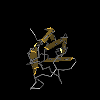?
 
First immunoglobulin (Ig)-like constant domain in Robo (roundabout) receptors, and similar domains The members here are composed of the first immunoglobulin (Ig)-like domain in Roundabout (Robo) receptors. Robo receptors play a role in the development of the central nervous system (CNS), and are receptors of Slit protein. Slit is a repellant secreted by the neural cells in the midline. Slit acts through Robo to prevent most neurons from crossing the midline from either side. Three mammalian Robo homologs (Robo1, Robo2, and Robo3), and three mammalian Slit homologs (Slit1, Slit2, Slit3), have been identified. Commissural axons, which cross the midline, express low levels of Robo; longitudinal axons, which avoid the midline, express high levels of Robo. Robo1, Robo2, and Robo3 are expressed by commissural neurons in the vertebrate spinal cord and Slit1, Slit2,and Slit3 are expressed at the ventral midline. Robo3 is a divergent member of the Robo family which instead of being a positive regulator of Slit responsiveness, antagonizes Slit responsiveness in precrossing axons. The Slit-Robo interaction is mediated by the second leucine-rich repeat (LRR) domain of Slit and the two N-terminal Ig domains of Robo, Ig1 and Ig2. The primary Robo binding site for Slit2 has been shown by surface plasmon resonance experiments and mutational analysis to be is the Ig1 domain, while the Ig2 domain has been proposed to harbor a weak secondary binding site. |
